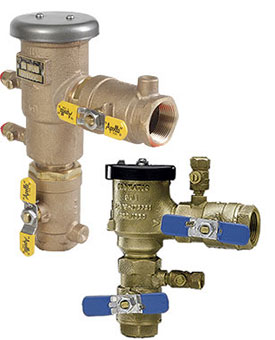PVB Backflow Preventer
What is Pressure Vacuum Breaker (PVB)
The pressure vacuum breaker assembly, or PVB, was built for serving the need for having a testable atmospheric vacuum breaker. PVBs comprise of an internally loaded air inlet and check valves. These two valves act independently while the former is located at the downstream of the latter. At each end of the PVB assembly, there are test cocks and shut- off valves. Being the advanced versions of atmospheric vacuum breakers, these are capable of being tested. It protects against backflow from the irrigation system to your home’s fresh water supply.
How does it work?
When there is a sudden drop in the main water supply’s pressure, backflow can occur. For instance, if the city’s water supply is interrupted all of a sudden, it can result in negative pressure in the home’s water supply creating a siphoning effect. PVB can be a savior for your home water supply’s backsiphonage issues. A PVB consists of a check device, also known as a check valve, and an air inlet that is open-air or vented to the atmosphere. Its check valve is designed such that it allows water to come in through and help the air inlet remain closed during normal conditions. As the air pressure increases and eventually exceeds the water pressure, the vented chamber opens up and breaks the suction effect caused by low pressure. This whole process hereby prevents the backflow of the water.
Features of PVB
PVBs can protect against non-health hazards or health hazards only in the case of back- siphonage issues and cannot protect against backpressure. A PVB is installed close to the water source before it can enter the sprinkler valves. In the system architecture, it must be installed at the highest point, that is, the sprinkler head or highest slope in the yard. It must be installed 12 inches above the flood level rim. They cannot be used with chemigation. They must be installed vertically with the inlet at the bottom. Also, if it is installed in a basement or some interior space, it requires an air gap drain. Some PVB assemblies have an in-built freeze protection relief valves but can only protect the assembly. A PVB should not be installed below grade or in a pit where air inlet becomes submerged in water.

How is it different than other Backflow Preventers?
The PVB backflow assembly is designed only to prevent backflow from backsiphonage. There is also a spill-resistant version (SVB) of PVB assembly that is used for indoor installations or else spillage can create a nuisance inside the house. The major difference lies in the fact that it has an outlet, and inlet shutoff, a single test cock, a bleed screw, and an air inlet valve.SVB has a different mechanism of operation – it closes the air inlet before the check valve opens.
Why is PVB the best for Backflow Prevention?
Apart from its attractive price range, PVB’s most beneficial feature is its simplicity. Due to its simplicity, this assembly is easy to install, maintain, and repair. It has fewer parts and a lightweight and compact body that makes it a low-maintenance and cost-effective solution for high-hazard applications based on irrigation (commercial or residential).
We use PVB devices that meet the requirements laid out by the American Water Works Association (AWWA) Standard for Pressure Vacuum Breaker Assembly (ASSE 1020, CSAB64.1.2) and approved by labs sanctioned by the Conference of State Sanitary Engineers.
It is our mission to provide smart water backflow services, installation services as well as repair services to help solve all your backflow problems. Call us now for booking our services!
